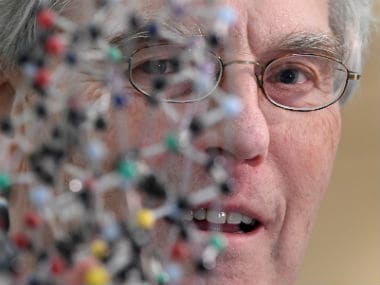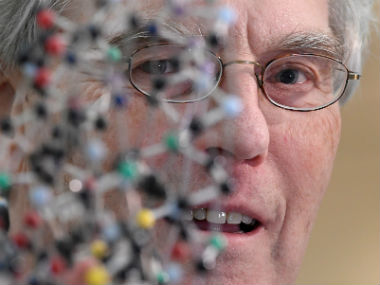A trio of Swiss, American, and British scientists won the 2017 Nobel chemistry prize on Wednesday for developing cryo-electron microscopy, allowing researchers to see biological molecules frozen in action.
[caption id=“attachment_4112493” align=“alignleft” width=“380”]  The trio won the Nobel Peace Prize in Chemistry. Reuters.[/caption]
The work by Jacques Dubochet, Joachim Frank, and Richard Henderson makes it possible to image proteins and other molecules after freezing them rapidly to preserve their shape, providing a powerful new tool for medical research.
“It’s like frames in a movie. Each of these pictures **represents** a frame and they can be put together into a movie and we can see what the molecules do,” said Peter Brzezinski, a member of the Nobel committee for chemistry.
The new approach fills a previously blank space by generating images of everything from the surface of the Zika virus to proteins that cause antibiotic resistance or are involved in Alzheimer‘s.
The Royal Swedish Academy of Sciences, which awarded the 9 million Swedish crown ($1.1 million) prize, said the technology had moved biochemistry into a new era.
By freezing biomolecules mid-movement, scientists can unravel previously unseen processes — a major advance both for basic understanding and the potential development of new drugs.
Scottish-born scientist Henderson used an electron microscope to generate a three-dimensional image of a protein at an atomic resolution, showing the potential of the technology.
Until then, electron microscopes were only seen as suitable for imaging dead matter, because the powerful electron beam destroyed the biological material.
His breakthrough was further developed by German-born scientist Frank, a US citizen, while Dubochet of Switzerland used rapidly frozen water to preserve the natural shape of the biomolecules.
Frank said cryo-electron microscopy had “immense” potential for medical research, which is increasingly focused on processes inside cells, but it would take time for this to play out — and he was taken aback by news of the award.
“I was overwhelmed. I thought the chances of winning a Nobel prize were miniscule,” he told a news briefing by telephone. Mapping disease Henderson was equally taken aback and said he had rejected the first phone call from the Swedish academy on Wednesday before picking up the second time.
“The three of us who have been awarded the prize are sort of acting on behalf of the whole field,” he told a news conference in Cambridge, England.
Understanding the structure of proteins and working out how they interact in the body should spark fresh approaches to drug development, just as earlier advances had produced today’s multibillion-dollar biotech drugs, he added.
“In a few years, maybe five years, we might know most of the structures … it’s quite an exciting time,” Henderson said.
Indeed, cryo-electron microscopy is already delivering results, such as the recent discovery of the structure of tau protein filaments in Alzheimer’s disease.
It was also put to work last year in the fight against Zika, when the mosquito-borne virus was linked to an epidemic of brain-damaged babies in Brazil.
As alarm about the outbreak spread, scientists were able to generate three-dimensional images of Zika at the atomic level, jump-starting the search for potential drugs and vaccines.
“The use of these methods has completely revolutionised structural biology so everyone now wants to buy this type of equipment and start this type of research, all over the world,” Johan Aqvist, another Nobel committee member, told Reuters.
US-based Thermo Fisher Scientific is a leading supplier of cryo-electron microscopy instruments. Chemistry is the third of this year’s Nobel Prizes after the winners of the medicine and physics prizes were announced earlier this week.
The prizes **are named** after Alfred Nobel, the inventor of dynamite, and have been awarded since 1901 for achievements in science, literature and peace, in accordance with his will.
While the chemistry award has sometimes been overshadowed by the towering reputations of physics winners such as Albert Einstein, laureates include ground-breaking scientists such as radioactivity pioneers Ernest Rutherford and Marie Curie, though she also won the physics prize.
The award passed over one of the highest-profile fields of research, the so-called CRISPR-Cas9 gene editing technology that earlier this year allowed U.S. scientists to alter genes in a human embryo to correct a disease-causing mutation.


)



